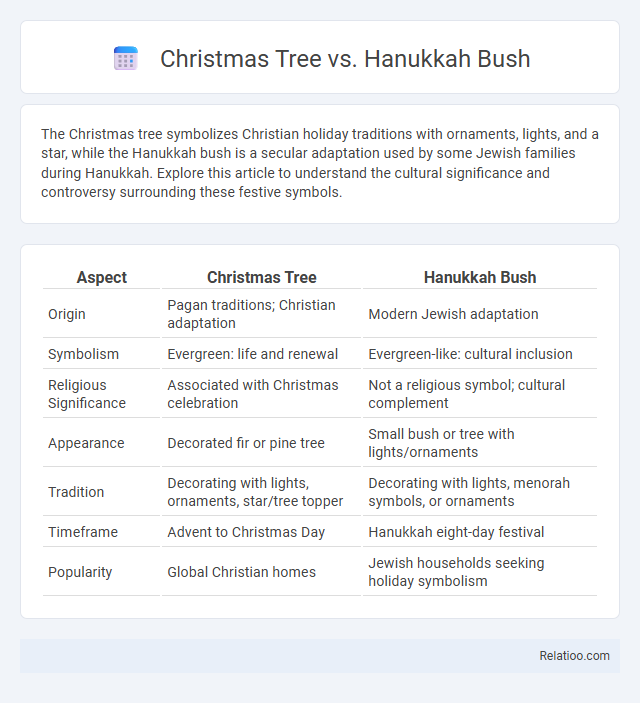The Christmas tree symbolizes Christian holiday traditions with ornaments, lights, and a star, while the Hanukkah bush is a secular adaptation used by some Jewish families during Hanukkah. Explore this article to understand the cultural significance and controversy surrounding these festive symbols.
Table of Comparison
| Aspect | Christmas Tree | Hanukkah Bush |
|---|---|---|
| Origin | Pagan traditions; Christian adaptation | Modern Jewish adaptation |
| Symbolism | Evergreen: life and renewal | Evergreen-like: cultural inclusion |
| Religious Significance | Associated with Christmas celebration | Not a religious symbol; cultural complement |
| Appearance | Decorated fir or pine tree | Small bush or tree with lights/ornaments |
| Tradition | Decorating with lights, ornaments, star/tree topper | Decorating with lights, menorah symbols, or ornaments |
| Timeframe | Advent to Christmas Day | Hanukkah eight-day festival |
| Popularity | Global Christian homes | Jewish households seeking holiday symbolism |
Introduction: Symbols of Holiday Traditions
The Christmas tree, a traditional evergreen adorned with lights and ornaments, symbolizes the festive spirit of Christmas and the celebration of hope and renewal. The Hanukkah bush, while less traditional, serves as a decorative element in some Jewish households to mark Hanukkah, often featuring blue and white decorations reflecting the holiday's themes of light and miracle. Decorating these symbols enhances holiday ambiance and expresses cultural identity, bringing families together through meaningful rituals.
Historical Origins: Christmas Tree and Hanukkah Bush
The Christmas tree originated in 16th-century Germany, symbolizing eternal life with its evergreen branches and later popularized across Europe and North America through Christian traditions. The Hanukkah bush, a more recent phenomenon, emerged in the 20th century among some Jewish families in the United States as a way to incorporate festive decorations similar to Christmas trees while maintaining cultural identity during Hanukkah. Both traditions reflect historical adaptations of religious and cultural symbolism in home decorating practices during winter celebrations.
Religious Significance Compared
A Christmas tree symbolizes the Christian celebration of Jesus Christ's birth, representing eternal life through its evergreen nature and often adorned with lights and ornaments reflecting biblical themes. The Hanukkah bush, though less traditional and sometimes viewed as controversial, serves as a secular decoration during Hanukkah, reflecting Jewish cultural identity without deep religious significance like the menorah. Decorating practices for Christmas emphasize the joy and spiritual anticipation of Christ's arrival, whereas Hanukkah decorations focus more on commemorating the miracle of the oil and Jewish perseverance during the Maccabean revolt.
Cultural Evolution and Adaptation
Christmas trees, Hanukkah bushes, and decorating traditions illustrate the cultural evolution and adaptation of holiday practices across different communities. These symbols reflect how You can blend religious and secular elements, highlighting the dynamic interplay of identity, heritage, and societal influences. Over time, they embody the increasing inclusivity and personalization of festive celebrations in diverse cultural landscapes.
Decoration Styles and Symbolism
Christmas trees symbolize life and renewal, often adorned with lights, ornaments, and a star or angel atop, reflecting Christian traditions. Hanukkah bushes, inspired by menorahs, feature blue and white decorations such as dreidels and gelt, representing the miracle of the oil and Jewish heritage. Your choice in decoration style expresses cultural identity and spiritual meaning, blending personal aesthetics with powerful symbols.
Family Customs and Community Practices
Christmas trees symbolize family unity and religious tradition, often becoming the focal point of communal gatherings and gift exchanges during the holiday season. Hanukkah bushes, while less traditional, provide a contemporary alternative for some Jewish families seeking to blend cultural practices with festive decoration. Decorating customs vary widely, reflecting the rich diversity of community practices, with both Christmas trees and Hanukkah bushes serving as expressions of heritage, identity, and shared celebration.
Controversies and Debates
The Christmas tree often sparks debates regarding its commercialization and religious symbolism, with some critics arguing it dilutes Christmas's spiritual meaning. The Hanukkah bush, a less traditional decoration, encounters controversy over its perceived imitation of Christmas customs, sparking discussions on cultural appropriation and identity preservation within Jewish communities. Decorating practices in general ignite debates around inclusivity, secularism, and the balancing of diverse holiday expressions in public and private spaces.
Interfaith Homes: Blending Traditions
In interfaith homes, blending traditions often involves combining the symbolic Christmas Tree with the Hanukkah Bush to honor both cultural heritages during the holiday season. Decorating your home with elements from both celebrations fosters a shared environment of respect and unity, highlighting the unique customs of each faith. You can create meaningful family moments by integrating lights, ornaments, and symbols that reflect the joyous spirit of Christmas and Hanukkah together.
Modern Trends and Popularity
Modern holiday decorating trends show a rising popularity of the Hanukkah Bush as a secular, inclusive alternative to the traditional Christmas Tree, especially among interfaith families seeking representation. Christmas Trees remain the most iconic and widely embraced symbol, with innovations like eco-friendly materials and themed LED lighting enhancing their appeal. Decorating styles now blend cultural elements and personalized aesthetics, reflecting growing diversity and individual expression in holiday celebrations.
Conclusion: Embracing Diversity in Holiday Celebrations
Holiday celebrations thrive on diversity, with Christmas trees and Hanukkah bushes symbolizing unique cultural traditions that enrich festive experiences. Decorating your home with either or both highlights respect for varied customs and fosters inclusivity during the holiday season. Embracing these differences allows you to create meaningful connections and celebrate the spirit of togetherness.

Infographic: Christmas Tree vs Hanukkah Bush
 relatioo.com
relatioo.com